Curcumin–Piperine Self-Nanoemulsifying Delivery in Zanthoxylum rhetsa Seed Oil Attenuates Cuprizone-Induced Frontal Cortex Toxicity
Abstract
1. Introduction
2. Results
2.1. GC-MS Analysis of Zanthoxylum rhetsa Seed Oil
2.2. Effects of Cuprizone and Nanoformulations on TDM
2.3. Effects of Cuprizone and Nanoformulations on Mean Velocity
2.4. Effects of Cuprizone and Nanoformulations on Grip Strength
2.5. Effects of Cuprizone and Nanoformulations on Motor Coordination and Balance
2.6. Effects of Nanoformulations on Antioxidants Levels
2.7. Effects of Nanoformulations on MBP Levels
2.8. Effects of Nanoformulations on AChE Levels
2.9. Effects of Nanoformulations on CD4 and CD8 Levels
2.10. Effects of Nanoformulations on the mRNA Levels of BDNF, CREB, TNFα, and IL-1β
2.11. Effects of Nanoformulations on the Protein Levels of BDNF, CREB, TNFα, and IL-1β
2.12. Histological Examinations
3. Discussion
Strengths and Limitations
4. Materials and Methods
4.1. Animals
4.2. Drug Preparations
4.3. GC-MS Characterization of Zanthoxylum rhetsa Seed Oil
4.4. Experimental Design
4.5. Sample Collection
4.6. Grip Strength Test
4.7. Open Field Test
4.8. Rotarod Test
4.9. Histological Examination
4.10. Biochemical Analysis
4.11. RNA Extraction and cDNA Synthesis
4.12. Gene Expression Analysis
4.13. Statistical Analysis
5. Conclusions
Author Contributions
Funding
Institutional Review Board Statement
Data Availability Statement
Acknowledgments
Conflicts of Interest
References
- Kumar, D.R.; Aslinia, F.; Yale, S.H.; Mazza, J.J. Jean-Martin Charcot: The Father of Neurology. Clin. Med. Res. 2011, 9, 46–49. [Google Scholar] [CrossRef] [PubMed]
- Mix, E.; Meyer-Rienecker, H.; Hartung, H.-P.; Zettl, U.K. Animal models of multiple sclerosis—Potentials and limitations. Prog. Neurobiol. 2010, 92, 386–404. [Google Scholar] [CrossRef]
- Dobson, R.; Giovannoni, G. Multiple sclerosis—A review. Eur. J. Neurol. 2019, 26, 27–40. [Google Scholar] [CrossRef]
- Gao, C.; Jiang, J.; Tan, Y.; Chen, S. Microglia in neurodegenerative diseases: Mechanism and potential therapeutic targets. Signal Transduct. Target. Ther. 2023, 8, 359. [Google Scholar] [CrossRef]
- Gudi, V.; Gingele, S.; Skripuletz, T.; Stangel, M. Glial response during cuprizone-induced de- and remyelination in the CNS: Lessons learned. Front. Cell Neurosci. 2014, 8, 73. [Google Scholar] [CrossRef]
- Praet, J.; Guglielmetti, C.; Berneman, Z.; Van der Linden, A.; Ponsaerts, P. Cellular and molecular neuropathology of the cuprizone mouse model: Clinical relevance for multiple sclerosis. Neurosci. Biobehav. Rev. 2014, 47, 485–505. [Google Scholar] [CrossRef]
- Brooks, S.P.; Dunnett, S.B. Tests to assess motor phenotype in mice: A user’s guide. Nat. Rev. Neurosci. 2009, 10, 519–529. [Google Scholar] [CrossRef]
- Haider, L. Inflammation, Iron, Energy Failure, and Oxidative Stress in the Pathogenesis of Multiple Sclerosis. Oxidative Med. Cell. Longev. 2015, 2015, 725370. [Google Scholar] [CrossRef] [PubMed]
- Haque, M.E.; Asanuma, M.; Higashi, Y.; Miyazaki, I.; Tanaka, K.-i.; Ogawa, N. Overexpression of Cu–Zn superoxide dismutase protects neuroblastoma cells against dopamine cytotoxicity accompanied by increase in their glutathione level. Neurosci. Res. 2003, 47, 31–37. [Google Scholar] [CrossRef] [PubMed]
- Pei, J.; Pan, X.; Wei, G.; Hua, Y. Research progress of glutathione peroxidase family (GPX) in redoxidation. Front. Pharmacol. 2023, 14, 1147414. [Google Scholar] [CrossRef]
- Moezzi, D.; Dong, Y.; Jain, R.W.; Lozinski, B.M.; Ghorbani, S.; D’Mello, C.; Wee Yong, V. Expression of antioxidant enzymes in lesions of multiple sclerosis and its models. Sci. Rep. 2022, 12, 12761. [Google Scholar] [CrossRef]
- Lock, C.; Hermans, G.; Pedotti, R.; Brendolan, A.; Schadt, E.; Garren, H.; Langer-Gould, A.; Strober, S.; Cannella, B.; Allard, J.; et al. Gene-microarray analysis of multiple sclerosis lesions yields new targets validated in autoimmune encephalomyelitis. Nat. Med. 2002, 8, 500–508. [Google Scholar] [CrossRef] [PubMed]
- Yamamoto, S.; Iwasa, K.; Yamagishi, A.; Haruta, C.; Maruyama, K.; Yoshikawa, K. Microglial depletion exacerbates axonal damage and motor dysfunction in mice with cuprizone-induced demyelination. J. Pharmacol. Sci. 2023, 153, 94–103. [Google Scholar] [CrossRef] [PubMed]
- Zhang, G.; Zhang, T.; Li, N.; Wu, L.; Gu, J.; Li, C.; Zhao, C.; Liu, W.; Shan, L.; Yu, P.; et al. Tetramethylpyrazine nitrone activates the BDNF/Akt/CREB pathway to promote post-ischaemic neuroregeneration and recovery of neurological functions in rats. Br. J. Pharmacol. 2018, 175, 517–531. [Google Scholar] [CrossRef]
- Al-kuraishy, H.M.; Sulaiman, G.M.; Mohammed, H.A.; Albukhaty, S.; Albuhadily, A.K.; Al-Gareeb, A.I.; Klionsky, D.J.; Abomughaid, M.M. The Compelling Role of Brain-Derived Neurotrophic Factor Signaling in Multiple Sclerosis: Role of BDNF Activators. CNS Neurosci. Ther. 2024, 30, e70167. [Google Scholar] [CrossRef]
- Saitta, K.S.; Lercher, L.D.; Sainato, D.M.; Patel, A.; Huang, Y.; McAuliffe, G.; Dreyfus, C.F. CHPG enhances BDNF and myelination in cuprizone-treated mice through astrocytic metabotropic glutamate receptor 5. Glia 2021, 69, 1950–1965. [Google Scholar] [CrossRef]
- Stadelmann, C.; Timmler, S.; Barrantes-Freer, A.; Simons, M. Myelin in the Central Nervous System: Structure, Function, and Pathology. Physiol. Rev. 2019, 99, 1381–1431. [Google Scholar] [CrossRef]
- Okagu, I.U.; Ndefo, J.C.; Aham, E.C.; Udenigwe, C.C. Zanthoxylum Species: A Comprehensive Review of Traditional Uses, Phytochemistry, Pharmacological and Nutraceutical Applications. Molecules 2021, 26, 4023. [Google Scholar] [CrossRef]
- Wen, J.; Xiang, Q.; Guo, J.; Zhang, J.; Yang, N.; Huang, Y.; Chen, Y.; Hu, T.; Rao, C. Pharmacological activities of Zanthoxylum L. plants and its exploitation and utilization. Heliyon 2024, 10, e33207. [Google Scholar] [CrossRef]
- Pham, C.B.; Cam, T.I.; Tran Thi, T.; Quan, P.M.; Toan, T.Q.; Do, H.N.; Thu Thuy, D.T.; Nguyen, T.T.; Trinh, A.V.; Pham, T.H.M.; et al. The Chemical Composition and Biological Activities of Essential Oils from Zanthoxylum rhetsa Grown in Son La, Northwest Vietnam. J. Food Qual. 2021, 2021, 9922283. [Google Scholar] [CrossRef]
- Kanchanadumkerng, P.; Sato, V.H.; Charoenthai, N.; Suksawat, T.; Lomarat, P.; Chewchinda, S. Formulation optimization of orodispersible film containing essential oil from fruits of Zanthoxylum rhetsa (Roxb.) DC. using response surface methodology and evaluation of its antioxidant, and antiglycation activities. Food Hydrocoll. Health 2025, 7, 100220. [Google Scholar] [CrossRef]
- Duangyod, T.; Phuneerub, P.; Maneerat, W.; Charoensub, R. Quality evaluation of Zanthoxylum rhetsa fruits and seeds—A Thai traditional medicine. Indian J. Tradit. Knowl. 2020, 19, 335–340. [Google Scholar] [CrossRef]
- Hewlings, S.J.; Kalman, D.S. Curcumin: A Review of Its’ Effects on Human Health. Foods 2017, 6, 92. [Google Scholar] [CrossRef]
- Peng, Y.; Ao, M.; Dong, B.; Jiang, Y.; Yu, L.; Chen, Z.; Hu, C.; Xu, R. Anti-Inflammatory Effects of Curcumin in the Inflammatory Diseases: Status, Limitations and Countermeasures. Drug Des. Dev. Ther. 2021, 15, 4503–4525. [Google Scholar] [CrossRef]
- Geng, S.; Wang, S.; Zhu, W.; Xie, C.; Li, X.; Wu, J.; Zhu, J.; Jiang, Y.; Yang, X.; Li, Y.; et al. Curcumin suppresses JNK pathway to attenuate BPA-induced insulin resistance in LO2 cells. Biomed. Pharmacother. 2018, 97, 1538–1543. [Google Scholar] [CrossRef]
- Zoi, V.; Kyritsis, A.P.; Galani, V.; Lazari, D.; Sioka, C.; Voulgaris, S.; Alexiou, G.A. The Role of Curcumin in Cancer: A Focus on the PI3K/Akt Pathway. Cancers 2024, 16, 1554. [Google Scholar] [CrossRef] [PubMed]
- Sathyabhama, M.; Priya Dharshini, L.C.; Karthikeyan, A.; Kalaiselvi, S.; Min, T. The Credible Role of Curcumin in Oxidative Stress-Mediated Mitochondrial Dysfunction in Mammals. Biomolecules 2022, 12, 1405. [Google Scholar] [CrossRef]
- Tripathi, A.K.; Ray, A.K.; Mishra, S.K. Molecular and pharmacological aspects of piperine as a potential molecule for disease prevention and management: Evidence from clinical trials. Beni-Suef Univ. J. Basic. Appl. Sci. 2022, 11, 16. [Google Scholar] [CrossRef]
- Kazi, M.; Shahba, A.A.; Alrashoud, S.; Alwadei, M.; Sherif, A.Y.; Alanazi, F.K. Bioactive Self-Nanoemulsifying Drug Delivery Systems (Bio-SNEDDS) for Combined Oral Delivery of Curcumin and Piperine. Molecules 2020, 25, 1703. [Google Scholar] [CrossRef] [PubMed]
- Tiwari, A.; Mahadik, K.R.; Gabhe, S.Y. Piperine: A comprehensive review of methods of isolation, purification, and biological properties. Med. Drug Discov. 2020, 7, 100027. [Google Scholar] [CrossRef]
- Covas, M.-I. Olive oil and the cardiovascular system. Pharmacol. Res. 2007, 55, 175–186. [Google Scholar] [CrossRef] [PubMed]
- Wang, J.; Yang, F.; Guo, J.; Zou, T.; Liu, Y.; Song, H. Characterization of key aroma-active compounds in Zanthoxylum schinifolium by sensory evaluation and multiple instrumental analyses. J. Food Compos. Anal. 2024, 136, 106848. [Google Scholar] [CrossRef]
- Cowan, M.M. Plant Products as Antimicrobial Agents. Clin. Microbiol. Rev. 1999, 12, 564–582. [Google Scholar] [CrossRef] [PubMed]
- Ma, Y.; Tian, J.; Chen, Y.; Chen, M.; Liu, Y.; Wei, A. Volatile Oil Profile of Prickly Ash (Zanthoxylum) Pericarps from Different Locations in China. Foods 2021, 10, 2386. [Google Scholar] [CrossRef]
- Morocho, V.; Eras, O.; Rojas, T.; Jiménez, B.; Roa, M.F.; Cartuche, L. Biological Activity and Chemical Composition of Essential Oil from Leaves and Fruits of Zanthoxylum mantaro (J.F.Macbr.) J.F.Macbr. Antibiotics 2025, 14, 216. [Google Scholar] [CrossRef] [PubMed]
- Biancotti, J.C.; Kumar, S.; de Vellis, J. Activation of inflammatory response by a combination of growth factors in cuprizone-induced demyelinated brain leads to myelin repair. Neurochem. Res. 2008, 33, 2615–2628. [Google Scholar] [CrossRef]
- Genchi, G.; Lauria, G.; Catalano, A.; Carocci, A.; Sinicropi, M.S. Neuroprotective Effects of Curcumin in Neurodegenerative Diseases. Foods 2024, 13, 1774. [Google Scholar] [CrossRef]
- Hillis, J.M.; Davies, J.; Mundim, M.V.; Al-Dalahmah, O.; Szele, F.G. Cuprizone demyelination induces a unique inflammatory response in the subventricular zone. J. Neuroinflamm. 2016, 13, 190. [Google Scholar] [CrossRef]
- Buonvicino, D.; Ranieri, G.; Chiarugi, A. Cuprizone-Dependent De/Remyelination Responses and Functional Correlates in Mouse Strains Adopted to Model Relapsing, Chronic and Progressive Experimental Autoimmune Encephalomyelitis. Neurotox. Res. 2021, 39, 658–666. [Google Scholar] [CrossRef]
- Abdul Manap, A.S.; Wei Tan, A.C.; Leong, W.H.; Yin Chia, A.Y.; Vijayabalan, S.; Arya, A.; Wong, E.H.; Rizwan, F.; Bindal, U.; Koshy, S.; et al. Synergistic Effects of Curcumin and Piperine as Potent Acetylcholine and Amyloidogenic Inhibitors with Significant Neuroprotective Activity in SH-SY5Y Cells via Computational Molecular Modeling and in vitro Assay. Front. Aging Neurosci. 2019, 11, 206. [Google Scholar] [CrossRef]
- Colović, M.B.; Krstić, D.Z.; Lazarević-Pašti, T.D.; Bondžić, A.M.; Vasić, V.M. Acetylcholinesterase inhibitors: Pharmacology and toxicology. Curr. Neuropharmacol. 2013, 11, 315–335. [Google Scholar] [CrossRef]
- Picciotto, M.R.; Higley, M.J.; Mineur, Y.S. Acetylcholine as a neuromodulator: Cholinergic signaling shapes nervous system function and behavior. Neuron 2012, 76, 116–129. [Google Scholar] [CrossRef] [PubMed]
- Ravichandar, R.; Gadelkarim, F.; Muthaiah, R.; Glynos, N.; Murlanova, K.; Rai, N.K.; Saraswat, D.; Polanco, J.J.; Dutta, R.; Pal, D.; et al. Dysregulated Cholinergic Signaling Inhibits Oligodendrocyte Maturation Following Demyelination. J. Neurosci. 2024, 44, 28. [Google Scholar] [CrossRef] [PubMed]
- Salehi, B.; Calina, D.; Docea, A.O.; Koirala, N.; Aryal, S.; Lombardo, D.; Pasqua, L.; Taheri, Y.; Marina Salgado Castillo, C.; Martorell, M.; et al. Curcumin’s Nanomedicine Formulations for Therapeutic Application in Neurological Diseases. J. Clin. Med. 2020, 9, 430. [Google Scholar] [CrossRef] [PubMed]
- Teleanu, D.M.; Niculescu, A.-G.; Lungu, I.I.; Radu, C.I.; Vladâcenco, O.; Roza, E.; Costăchescu, B.; Grumezescu, A.M.; Teleanu, R.I. An Overview of Oxidative Stress, Neuroinflammation, and Neurodegenerative Diseases. Int. J. Mol. Sci. 2022, 23, 5938. [Google Scholar] [CrossRef]
- Polachini, C.R.N.; Spanevello, R.M.; Schetinger, M.R.C.; Morsch, V.M. Cholinergic and purinergic systems: A key to multiple sclerosis? J. Neurol. Sci. 2018, 392, 8–21. [Google Scholar] [CrossRef]
- Fresegna, D.; Bullitta, S.; Musella, A.; Rizzo, F.R.; De Vito, F.; Guadalupi, L.; Caioli, S.; Balletta, S.; Sanna, K.; Dolcetti, E.; et al. Re-Examining the Role of TNF in MS Pathogenesis and Therapy. Cells 2020, 9, 2290. [Google Scholar] [CrossRef]
- Stone, S.; Jamison, S.; Yue, Y.; Durose, W.; Schmidt-Ullrich, R.; Lin, W. NF-κB activation protects oligodendrocytes against inflammation. J. Neurosci. 2017, 37, 9332–9344. [Google Scholar] [CrossRef]
- Kaddatz, H.; Joost, S.; Nedelcu, J.; Chrzanowski, U.; Schmitz, C.; Gingele, S.; Gudi, V.; Stangel, M.; Zhan, J.; Santrau, E.; et al. Cuprizone-induced demyelination triggers a CD8-pronounced T cell recruitment. Glia 2021, 69, 925–942. [Google Scholar] [CrossRef]
- Zirngibl, M.; Assinck, P.; Sizov, A.; Caprariello, A.V.; Plemel, J.R. Oligodendrocyte death and myelin loss in the cuprizone model: An updated overview of the intrinsic and extrinsic causes of cuprizone demyelination. Mol. Neurodegener. 2022, 17, 34. [Google Scholar] [CrossRef]
- Goverman, J.M. Immune Tolerance in Multiple Sclerosis. Immunol. Rev. 2011, 241, 228–240. [Google Scholar] [CrossRef]
- Moulton, V.R.; Tsokos, G.C. T cell signaling abnormalities contribute to aberrant immune cell function and autoimmunity. J. Clin. Investig. 2015, 125, 2220–2227. [Google Scholar] [CrossRef] [PubMed]
- Daverey, A.; Agrawal, S.K. Curcumin Protects against White Matter Injury through NF-κB and Nrf2 Cross Talk. J. Neurotrauma 2020, 37, 1255–1265. [Google Scholar] [CrossRef]
- Jin, W.; Botchway, B.O.A.; Liu, X. Curcumin Can Activate the Nrf2/HO-1 Signaling Pathway and Scavenge Free Radicals in Spinal Cord Injury Treatment. Neurorehabil Neural Repair. 2021, 35, 576–584. [Google Scholar] [CrossRef] [PubMed]
- Zhu, H.; Hu, E.; Guo, X.; Yuan, Z.; Jiang, H.; Zhang, W.; Tang, T.; Wang, Y.; Li, T. Promoting remyelination in central nervous system diseases: Potentials and prospects of natural products and herbal medicine. Pharmacol. Res. 2024, 210, 107533. [Google Scholar] [CrossRef] [PubMed]
- Koh, E.-J.; Seo, Y.-J.; Choi, J.; Lee, H.Y.; Kang, D.-H.; Kim, K.-J.; Lee, B.-Y. Spirulina maxima Extract Prevents Neurotoxicity via Promoting Activation of BDNF/CREB Signaling Pathways in Neuronal Cells and Mice. Molecules 2017, 22, 1363. [Google Scholar] [CrossRef]
- Abo Taleb, H.A.; Alghamdi, B.S. Neuroprotective Effects of Melatonin during Demyelination and Remyelination Stages in a Mouse Model of Multiple Sclerosis. J. Mol. Neurosci. 2020, 70, 386–402. [Google Scholar] [CrossRef]
- Aldhahri, R.S.; Alghamdi, B.S.; Alzahrani, N.A.; Bahaidrah, K.A.; Alsufiani, H.M.; Mansouri, R.A.; Ashraf, G.M. Biochanin A Improves Memory Decline and Brain Pathology in Cuprizone-Induced Mouse Model of Multiple Sclerosis. Behav. Sci. 2022, 12, 70. [Google Scholar] [CrossRef]
- Fan, H.-Y.; Wang, X.-K.; Li, X.; Ji, K.; Du, S.-H.; Liu, Y.; Kong, L.-L.; Xu, J.-C.; Yang, G.-Q.; Chen, D.-Q.; et al. Curcumin, as a pleiotropic agent, improves doxorubicin-induced nephrotic syndrome in rats. J. Ethnopharmacol. 2020, 250, 112502. [Google Scholar] [CrossRef]
- Takeshita, H.; Yamamoto, K.; Nozato, S.; Inagaki, T.; Tsuchimochi, H.; Shirai, M.; Yamamoto, R.; Imaizumi, Y.; Hongyo, K.; Yokoyama, S.; et al. Modified forelimb grip strength test detects aging-associated physiological decline in skeletal muscle function in male mice. Sci. Rep. 2017, 7, 42323. [Google Scholar] [CrossRef]
- Balkaya, M.; Kröber, J.M.; Rex, A.; Endres, M. Assessing post-stroke behavior in mouse models of focal ischemia. J. Cereb. Blood Flow Metab. 2013, 33, 330–338. [Google Scholar] [CrossRef] [PubMed]
- Dunham, N.W.; Miya, T.S. A note on a simple apparatus for detecting neurological deficit in rats and mice. J. Am. Pharm. Assoc. Am. Pharm. Assoc. 1957, 46, 208–209. [Google Scholar] [CrossRef] [PubMed]
- Sen, M.K.; Almuslehi, M.S.M.; Coorssen, J.R.; Mahns, D.A.; Shortland, P.J. Behavioural and histological changes in cuprizone-fed mice. Brain Behav. Immun. 2020, 87, 508–523. [Google Scholar] [CrossRef] [PubMed]
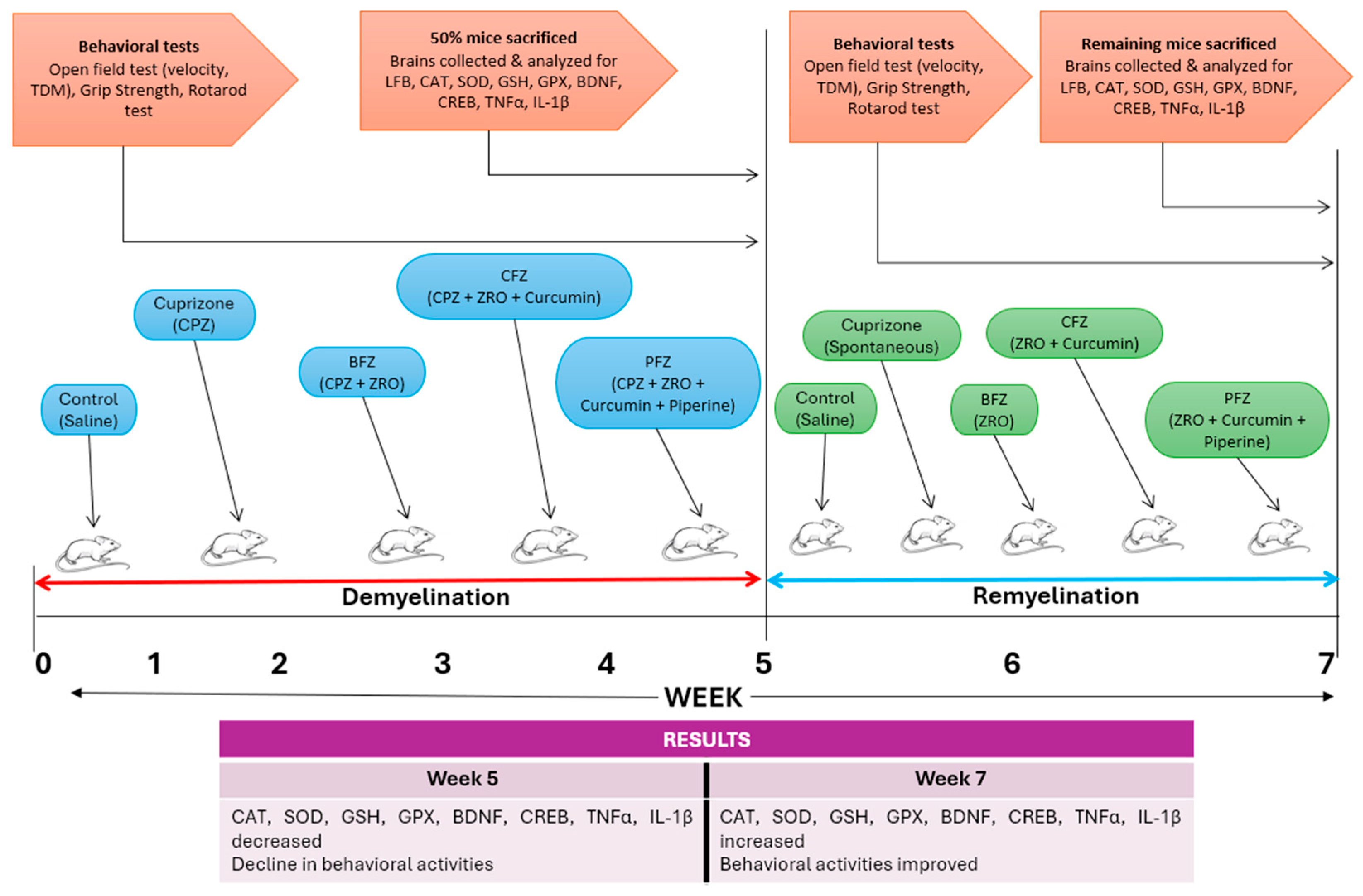
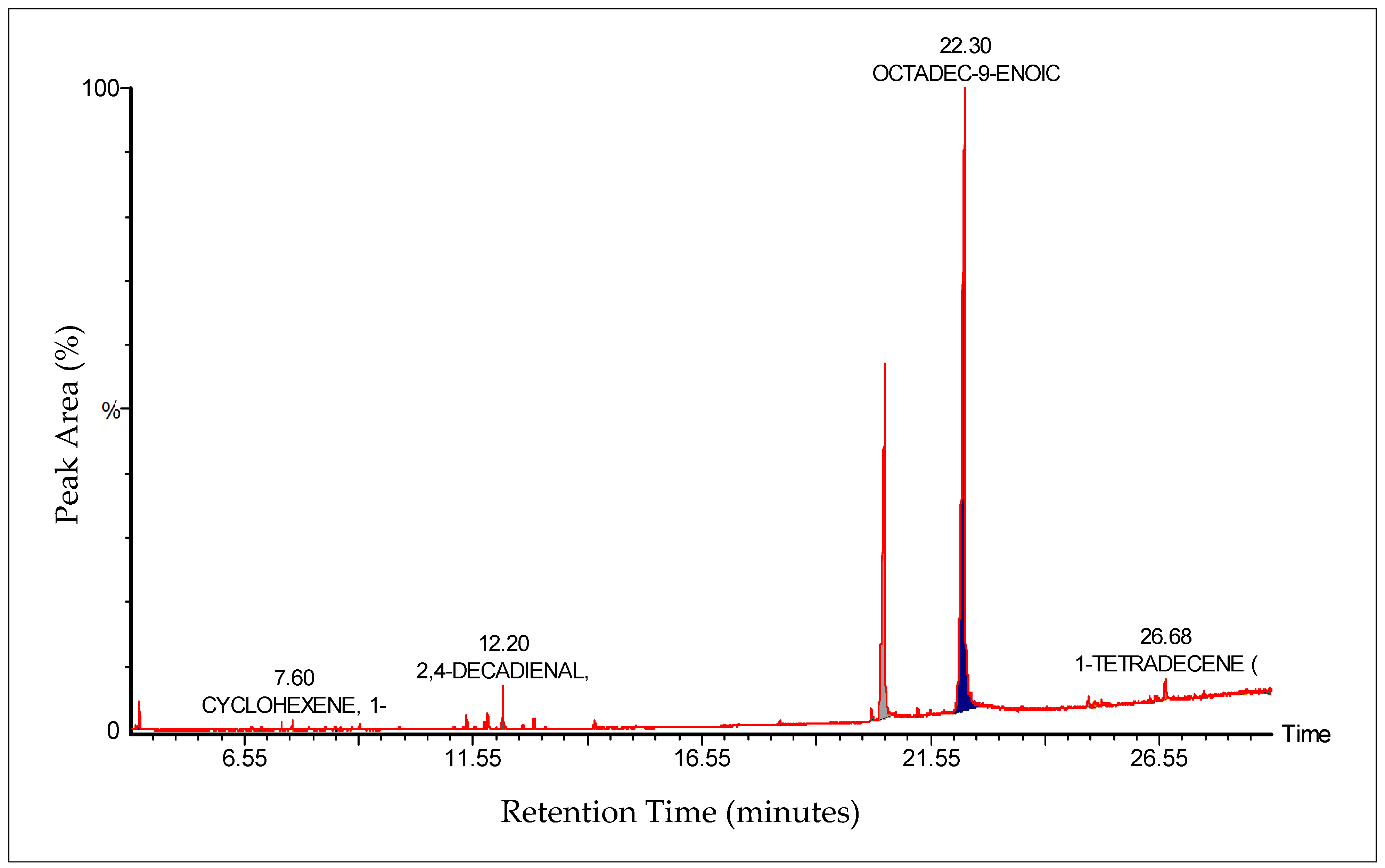
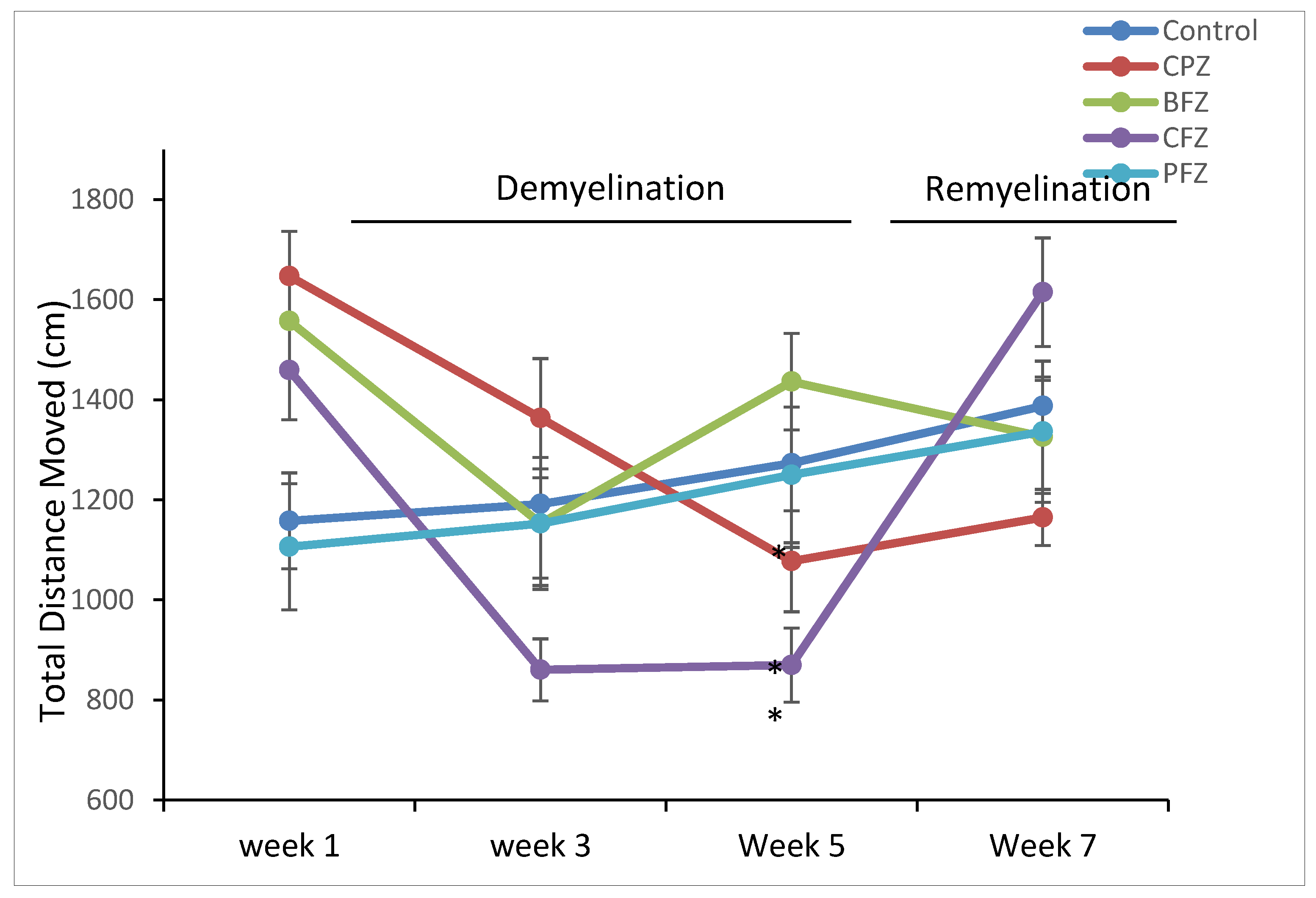
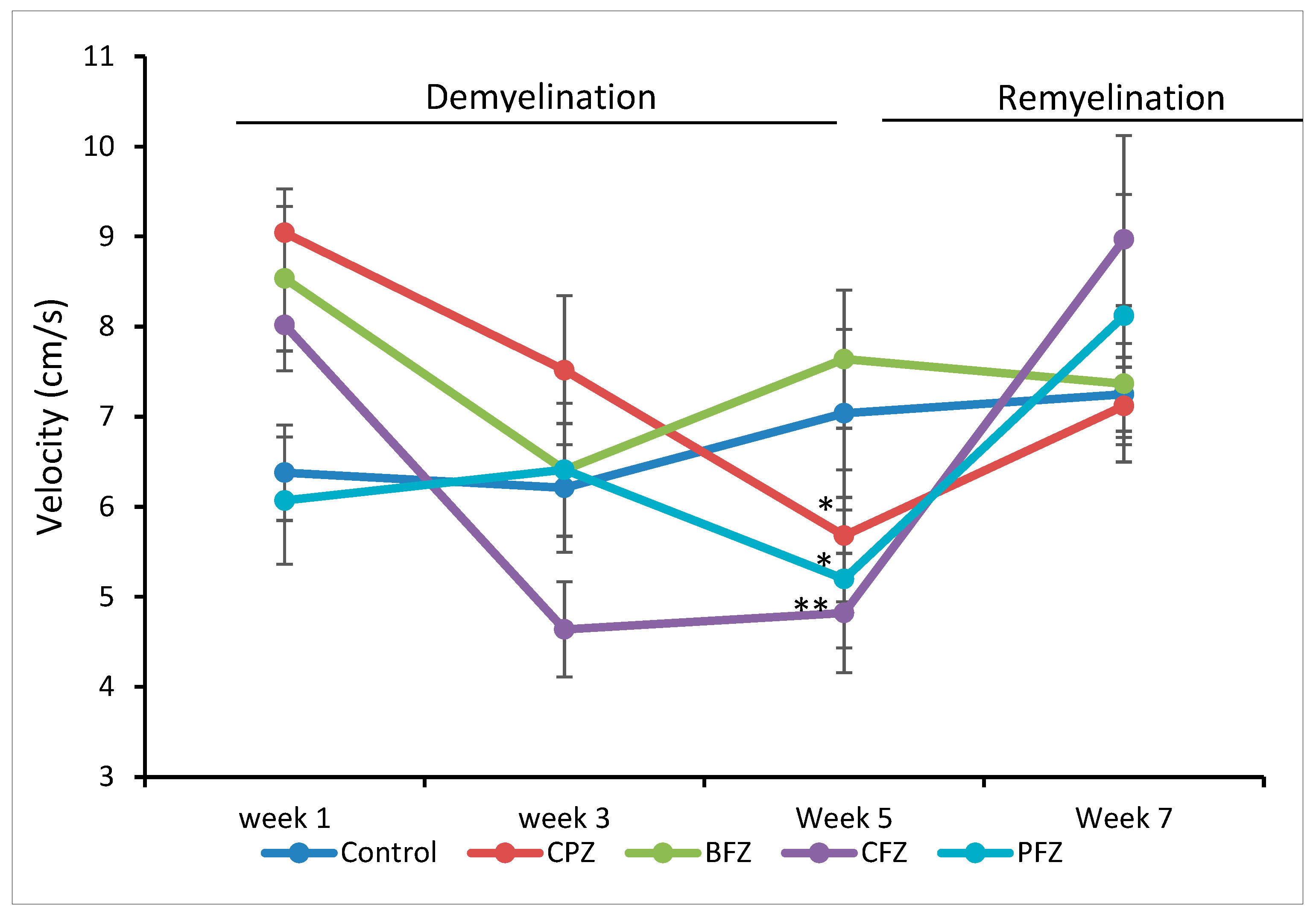
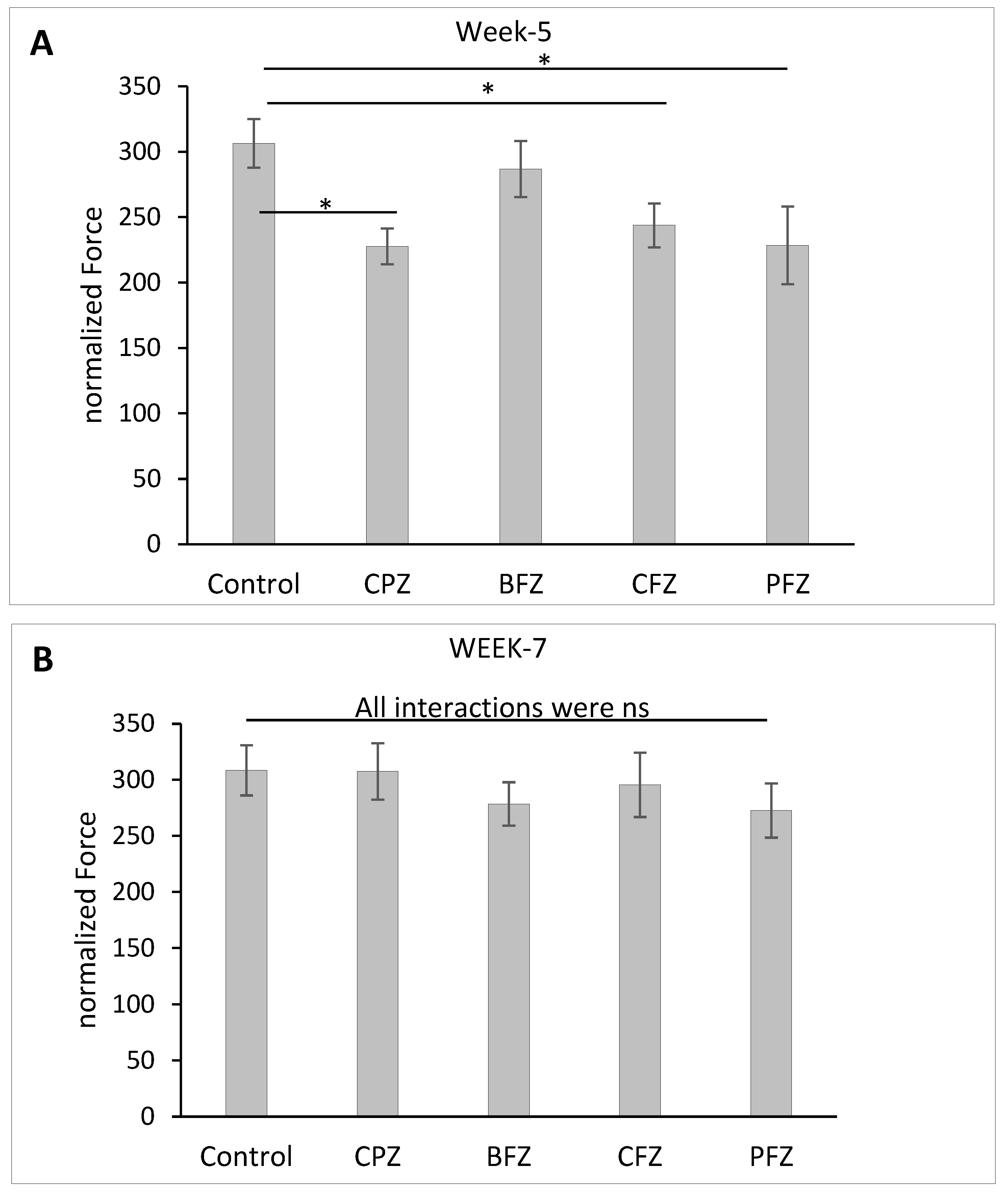
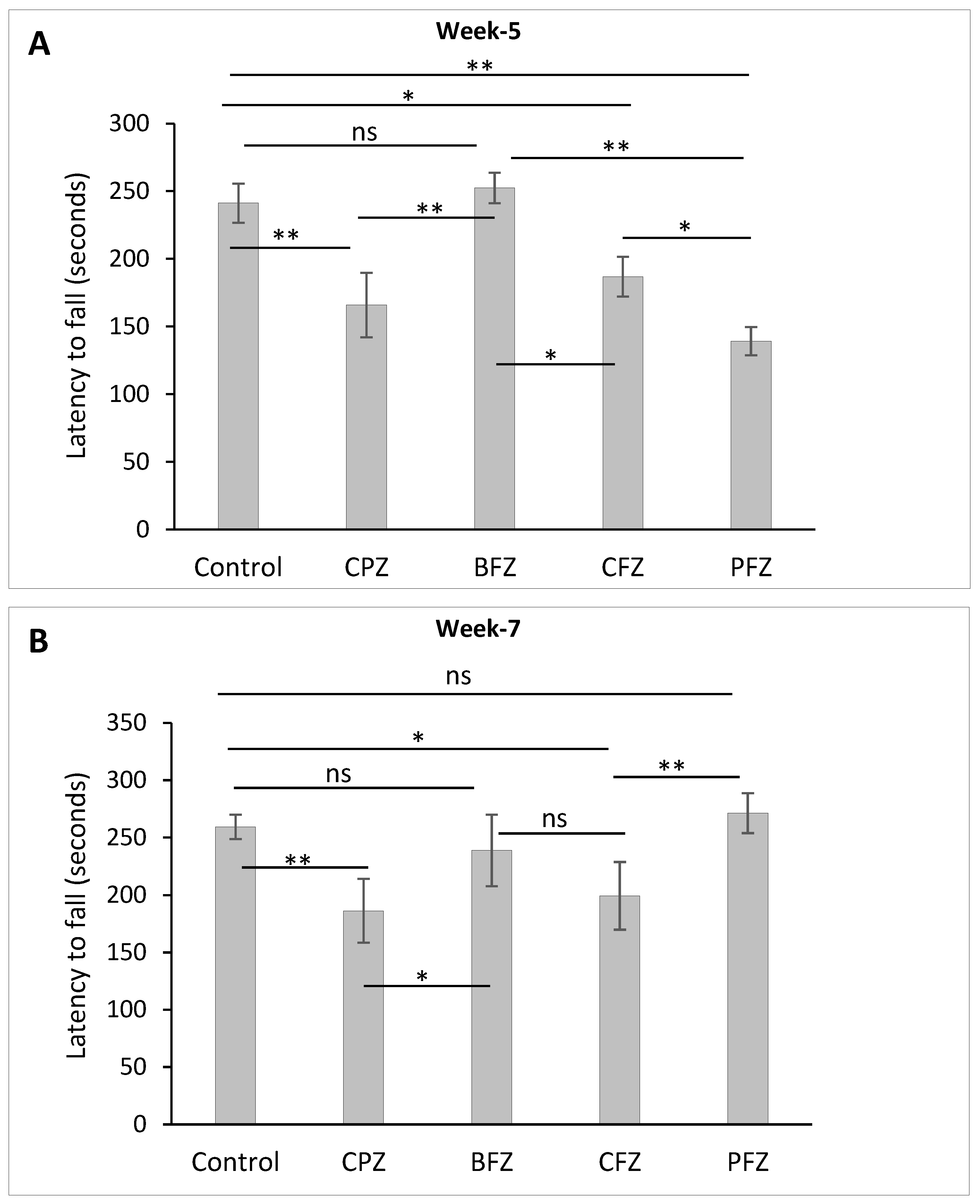

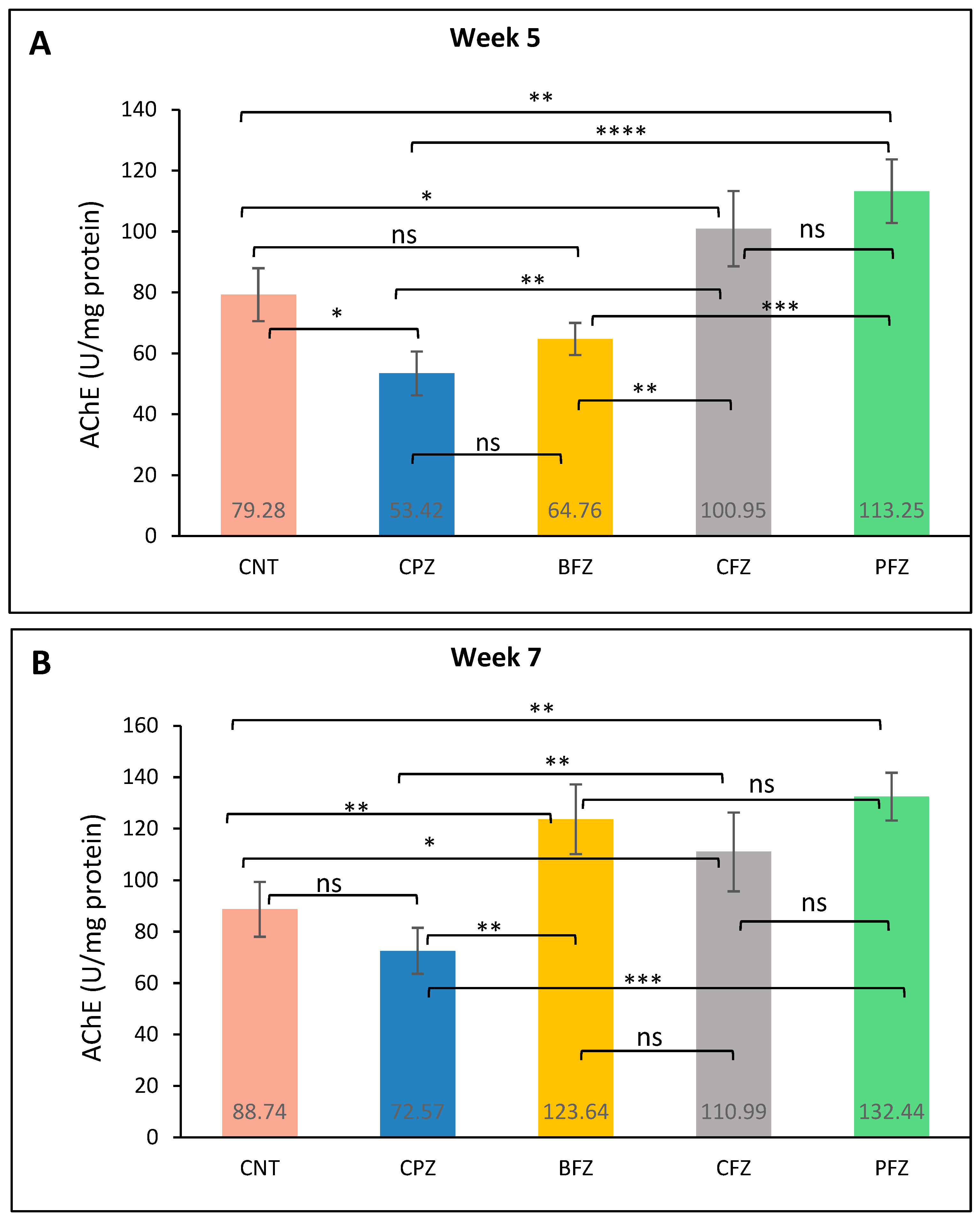
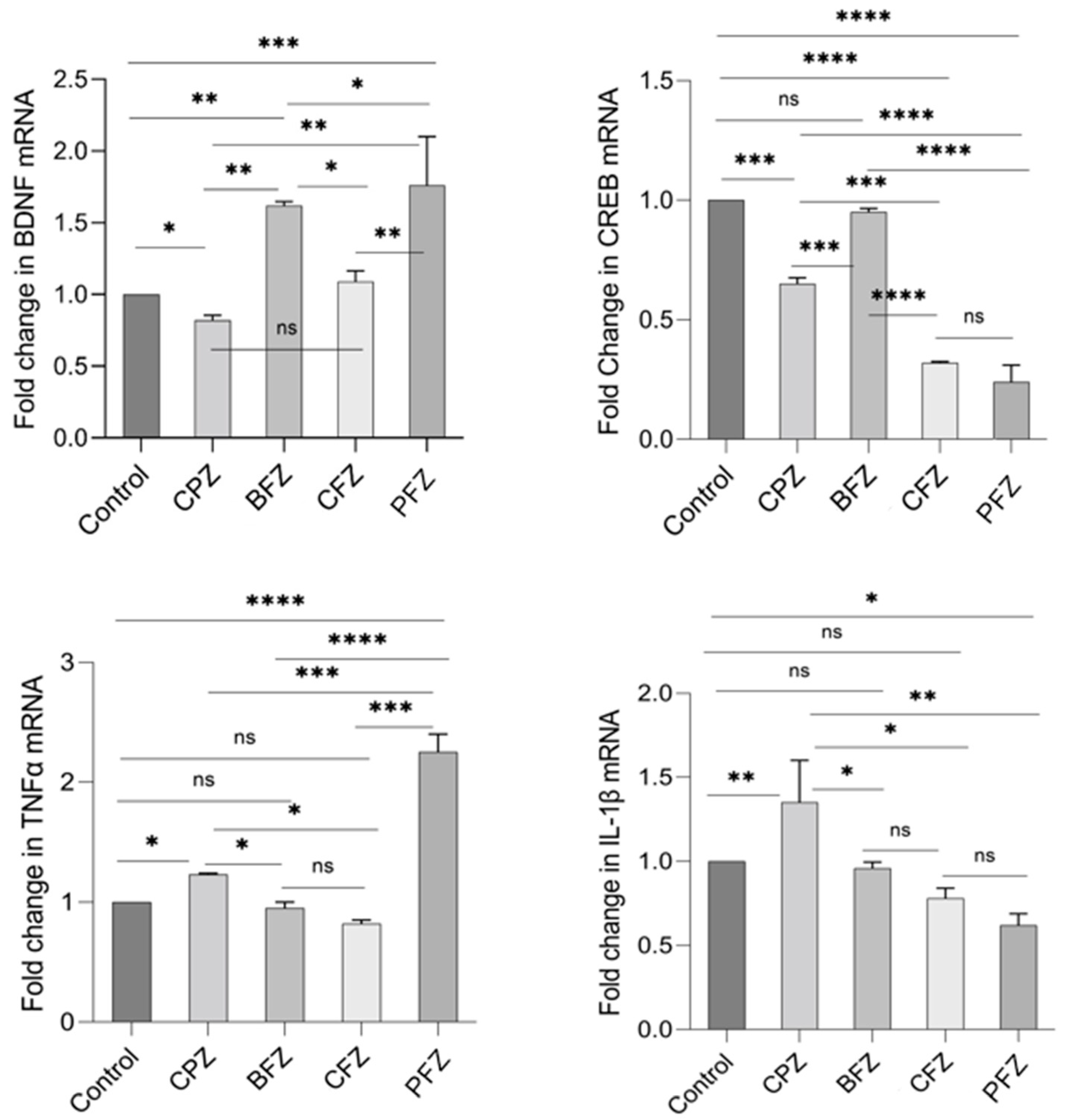
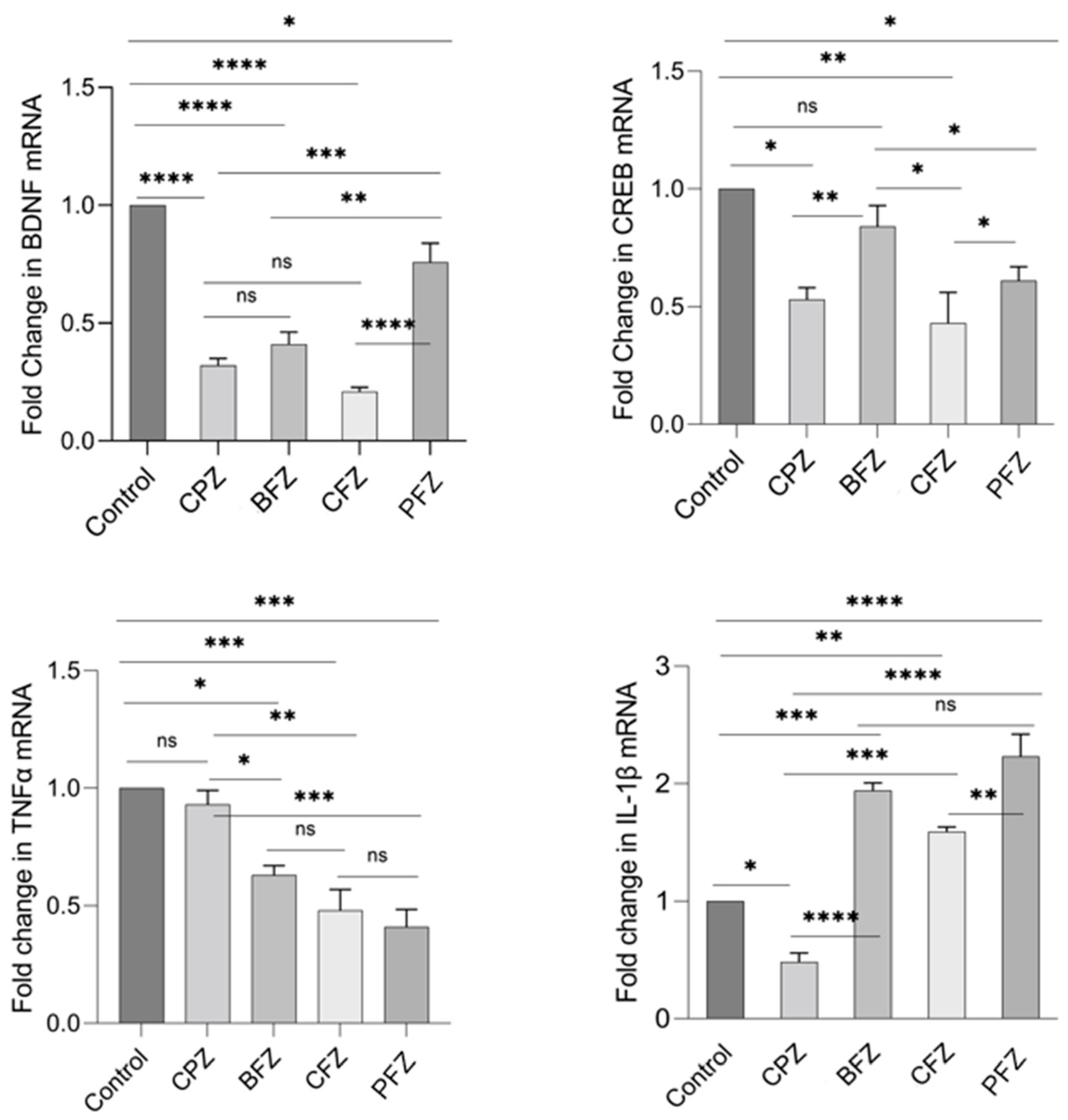
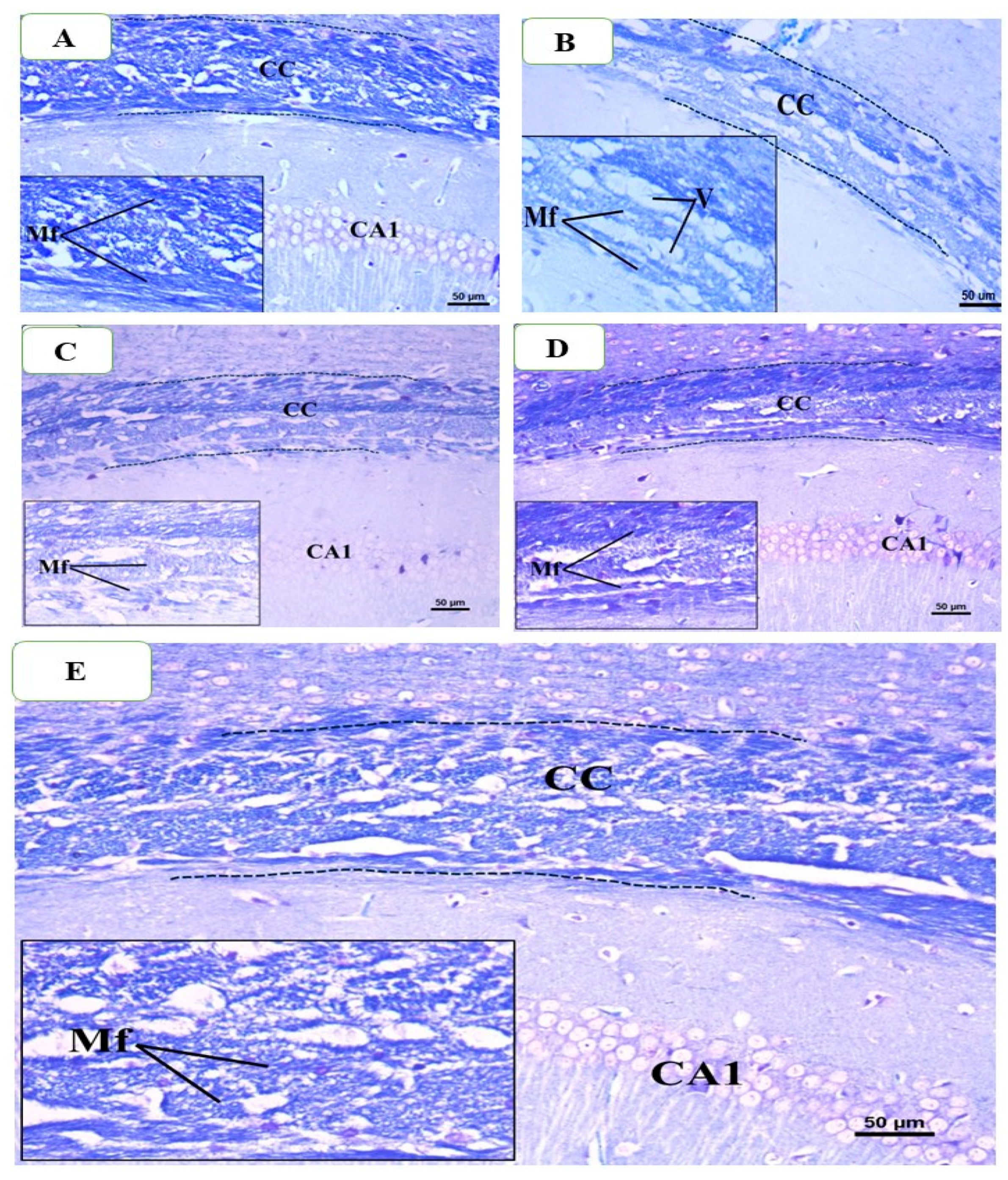
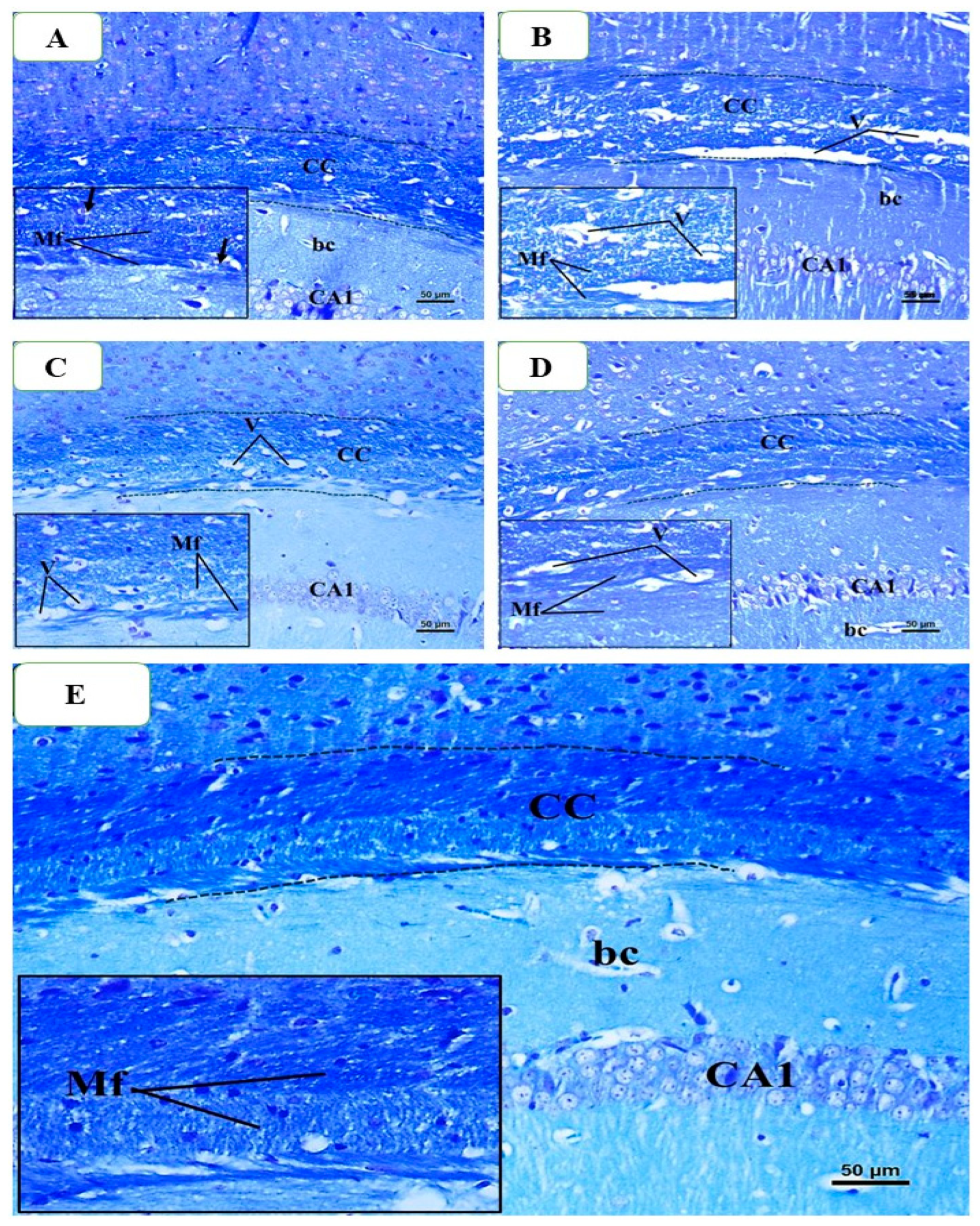
| S. No. | Chemical Constituents | RT (Minutes) | Area % |
|---|---|---|---|
| 1. | HEXANAL | 4.24 | 1.250 |
| 2. | HEXANOIC ACID | 6.92 | 0.310 |
| 3. | 2,4-HEPTADIENAL | 7.36 | 0.790 |
| 4. | 1-ETHYL-CYCLOHEXENE | 7.60 | 1.170 |
| 5. | TETRAHYDRO-5-METHYL-2-FURANMETHANOL | 8.33 | 0.480 |
| 6. | 4-METHYL-PHENOL | 8.55 | 0.280 |
| 7. | NONANAL | 9.07 | 0.230 |
| 8. | OCTANOIC ACID | 9.96 | 0.300 |
| 9. | 1-DODECANOL | 11.40 | 0.420 |
| 10. | (3Z,6Z)-DODECA-3,6-DIEN-1-OL | 11.80 | 0.220 |
| 11. | 2,4-DECADIENAL | 12.20 | 4.460 |
| 12. | DIHEXYLSULFIDE | 12.65 | 0.250 |
| 13. | TRANS-2-UNDECENAL | 12.89 | 0.420 |
| 14. | OXACYCLOTETRADECANE-2,11-DIONE | 14.22 | 0.770 |
| 15. | HEXADECANOIC ACID | 20.55 | 28.420 |
| 16. | OCTADEC-9-ENOIC ACID | 22.30 | 59.220 |
| 17. | METHYL ALPHA-KETOPALMITATE | 25.00 | 0.410 |
| 18. | 1-TETRADECENE | 26.69 | 0.600 |
| Group | Antioxidant Activity | |||||||
|---|---|---|---|---|---|---|---|---|
| CAT U/mg Protein | SOD U/mg Protein | GSH ng/mg Protein | GPX ng/mg Protein | |||||
| Week 5 | Week 7 | Week 5 | Week 7 | Week 5 | Week 7 | Week 5 | Week 7 | |
| CNT | 7.85 ± 0.55 | 8.22 ± 0.42 | 18.97 ± 1.15 | 28.38 ± 2.15 | 111.65 ± 4.05 | 120.33 ± 13.74 | 4.34 ± 0.91 | 3.61 ± 0.02 |
| CPZ | 5.59 ± 0.21 | 7.92 ± 0.08 | 12.34 ± 0.56 | 14.78 ± 1.99 | 57.28 ± 3.13 | 149.57 ± 16.87 | 2.24 ± 0.08 | 2.42 ± 0.07 |
| BFZ | 3.61 ± 0.38 | 6.44 ± 0.19 | 9.00 ± 0.94 | 19.25 ± 1.87 | 67.74 ± 3.14 | 132.03 ± 11.35 | 1.08 ± 0.13 | 4.22 ± 0.04 |
| CFZ | 6.74 ± 0.14 | 6.94 ± 0.14 | 11.25 ± 0.38 | 17.28 ± 0.92 | 74.44 ± 10.61 | 147.32 ± 14.9 | 1.04 ± 0.02 | 4.39 ± 0.03 |
| PFZ | 8.51 ± 1.16 | 10.42 ± 0.25 | 18.18 ± 0.98 | 34.20 ± 0.51 | 126.25 ± 15.7 | 138.01 ± 16.31 | 3.46 ± 0.34 | 3.35 ± 0.62 |
| p value | * CNT × CPZ; BFZ × CFZ ** CNT × BFZ; CFZ × PFZ *** CPZ × PFZ **** BFZ × PFZ ns = CNT × BFZ, CFZ; CPZ × BFZ, CFZ | * CPZ × BFZ * CNT × BFZ, CFZ; CPZ × CFZ; BFZ × PFZ; CFZ × PFZ *** CNT × PFZ; CPZ × PFZ ns = CNT × CPZ; BFZ × CFZ | ** CNT × CPZ; CPZ × PFZ; CFZ × PFZ **** CNT × BFZ *** CNT × CFZ; BFZ × PFZ ns = CNT × PFZ; CPZ × BFZ, CFZ; BFZ × CFZ | * CNT × PFZ; CPZ × BFZ, CFZ *** CNT × CPZ, BFZ; BFZ × CFZ, PFZ; CFZ × PFZ **** CNT × CFZ; CPZ × PFZ | * CNT × BFZ; CFZ × PFZ ** BFZ × PFZ **** CNT × CPZ; CPZ × BFZ, CFZ, PFZ ns = CNT × CFZ, PFZ; BFZ × CFZ | ** CFZ × PFZ; BFZ × CFZ, PFZ; CPZ × BFZ; CNT × CFZ, PFZ *** CNT × CPZ; CPZ × PFZ ns = CNT × BFZ; CPZ × CFZ | * CNT × CPZ; BFZ × PFZ; CFZ × PFZ ** CNT × BFZ, CFZ ns = CNT × PFZ; CPZ × BFZ, CFZ, PFZ; BFZ × CFZ | ** CPZ × BFZ, CFZ ns = all other interactions were non-significant |
| Group | CD4 (pg/mg Protein) | CD8 (ng/mg Protein) | ||||
|---|---|---|---|---|---|---|
| Week 5 | Week 7 | % Change | Week 5 | Week 7 | % Change | |
| CNT | 2725.25 ± 213.66 | 2585.69 ± 231.56 | 5.12 ↓ | 3.83 ± 0.46 | 5.18 ± 0.42 | 35.24 ↑ |
| CPZ | 18,466.57 ± 162.34 | 17,071.16 ± 138.48 | 7.56 ↓ | 11.93 ± 1.41 | 5.86 ± 0.74 | 50.88 ↓ |
| BFZ | 4557.21 ± 394.18 | 4497.18 ± 406.74 | 1.32 ↓ | 5.34 ± 0.68 | 3.65 ± 0.26 | 31.65 ↓ |
| CFZ | 3540.72 ± 276.44 | 1795.39 ± 128.62 | 49.29 ↓ | 3.35 ± 0.24 | 3.04 ± 0.22 | 6.25 ↓ |
| PFZ | 3302.33 ± 336.12 | 1298.19 ± 96.78 | 60.68 ↓ | 2.87 ± 0.22 | 2.26 ± 0.18 | 21.25 ↓ |
| p value | **** CNT × CPZ **** CPZ × BFZ, CFZ, PFZ ** BFZ × CNT * CNT × CFZ, PFZ NS = CFZ × PFZ | **** CNT × CPZ **** CPZ × BFZ, CFZ, PFZ *** BFZ × CNT ** CNT × BFZ ** PFZ × CNT * CFZ × CNT | **** CNT × CPZ **** CPZ × BFZ, CFZ, PFZ ** BFZ × CNT * CFZ × PFZ NS = CNT × CFZ | NS = CNT × CPZ *** CNT × PFZ ** CNT × BFZ, CFZ * PFZ × CFZ NS = BFZ × CFZ | ||
| Biomarker | Group | Concentration (pg/mg Protein) | Percent (%) Change in Relation to | p-Value | |
|---|---|---|---|---|---|
| CNT | CPZ | ||||
| BDNF | CNT | 542.16 ± 30.42 | 0.00 | 35.07 ↑ | * CPZ × CFZ; * BFZ × CFZ; * CFZ × PFZ; ** Control × CPZ, BFZ, PFZ; ** CPZ × BFZ, PFZ; NS = CNT × CFZ; BFZ × PFZ |
| CPZ | 401.39 ± 36.74 | 25.96 ↓ | 0.00 | ||
| BFZ | 801.24 ± 74.10 | 47.79 ↑ | 99.62 ↑ | ||
| CFZ | 596.41 ± 23.64 | 10.01 ↑ | 48.59 ↑ | ||
| PFZ | 853.84 ± 43.15 | 57.49 ↑ | 112.72 ↑ | ||
| CREB | CNT | 1859.19 ± 83.67 | 0.00 | 44.66 ↑ | ** CNT × CPZ; ** CPZ × BFZ; *** CPZ × CFZ, PFZ; *** CNT × CFZ, PFZ; **** BFZ × CFZ, PFZ; NS = CNT × BFZ |
| CPZ | 1285.22 ± 64.28 | 30.87 ↓ | 0.00 | ||
| BFZ | 1803.64 ± 92.37 | 2.99 ↓ | 40.34 ↑ | ||
| CFZ | 473.79 ± 27.61 | 74.52 ↓ | 63.14 ↓ | ||
| PFZ | 402.06 ± 17.55 | 78.37 ↓ | 68.72 ↓ | ||
| TNFα | CNT | 373.03 ± 13.67 | 0.00 | 15.71 ↓ | * CNT × CFZ; * CPZ × BFZ, CFZ; ** CNT × CPZ; **** CNT × PFZ; CPZ × PFZ; BFZ × PFZ; CFZ × PFZ; NS = CNT × BFZ; BFZ × PFZ |
| CPZ | 442.55 ± 29.47 | 18.64 ↑ | 0.00 | ||
| BFZ | 347.46 ± 16.52 | 6.85 ↓ | 21.49 ↓ | ||
| CFZ | 312.41 ± 23.25 | 16.25 ↓ | 29.41 ↓ | ||
| PFZ | 636.5 ± 56.32 | 70.63 ↑ | 43.83 ↑ | ||
| IL-1β | CNT | 66.79 ± 4.86 | 0.00 | 24.01 ↓ | * CNT × CPZ, CFZ; * BFZ × CFZ, PFZ; ** CNT × PFZ; *** CPZ × CFZ, PFZ; NS = CNT × BFZ; CFZ × PFZ |
| CPZ | 87.89 ± 5.94 | 31.59 ↑ | 0.00 | ||
| BFZ | 63.69 ± 3.97 | 4.64 ↓ | 27.53 ↓ | ||
| CFZ | 46.59 ± 3.16 | 30.24 ↓ | 46.99 ↓ | ||
| PFZ | 40.89 ± 2.95 | 38.78 ↓ | 53.48 ↓ | ||
| Biomarker | Group | Concentration (pg/mg Protein) | Percent (%) Change in Relation to | p-Value | |
|---|---|---|---|---|---|
| CNT | CPZ | ||||
| BDNF | CNT | 1047.09 ± 77.92 | 0.00 | 114.29 ↑ | * CPZ × BFZ; * BFZ × CFZ; * CFZ × PFZ ** CNT × BFZ, PFZ *** CNT × CPZ, CFZ NS = BFZ × PFZ |
| CPZ | 488.64 ± 36.19 | 53.33 ↓ | 0.00 | ||
| BFZ | 762.35 ± 74.62 | 27.19 ↓ | 56.01 ↑ | ||
| CFZ | 554.95 ± 35.68 | 47.00 ↓ | 13.57 ↑ | ||
| PFZ | 733.90 ± 61.29 | 29.91 ↓ | 50.19 ↑ | ||
| CREB | CNT | 917.7 ± 38.53 | 0.00 | 107.72 ↑ | *** CPZ × BFZ; * BFZ × CFZ, PFZ **** CNT × CPZ, CFZ, PFZ NS = CNT × BFZ; CPZ × CFZ, PFZ |
| CPZ | 441.8 ± 23.61 | 51.86 ↓ | 0.00 | ||
| BFZ | 839.47 ± 44.39 | 8.52 ↓ | 90.01 ↑ | ||
| CFZ | 364.91 ± 19.46 | 60.24 ↓ | 17.40 ↓ | ||
| PFZ | 470.51 ± 15.94 | 48.73 ↓ | 6.50 ↑ | ||
| TNFα | CNT | 529.45 ± 62.31 | 0.00 | 1.22 ↓ | * BFZ × PFZ *** CNT × BFZ; *** CPZ × BFZ **** CNT × CFZ, PFZ; *** CPZ × CFZ, PFZ NS = CNT × CPZ; BFZ × CFZ; CFZ × PFZ |
| CPZ | 536.0 ± 36.24 | 1.24 ↑ | 0.00 | ||
| BFZ | 338.24 ± 26.34 | 36.11 ↓ | 36.90 ↓ | ||
| CFZ | 270.3 ± 23.31 | 48.95 ↓ | 49.57 | ||
| PFZ | 227.47 ± 30.85 | 57.04 ↓ | 57.56 ↓ | ||
| IL-1β | CNT | 51.76 ± 3.14 | 0.00 | 109.81 ↑ | ** CNT × CFZ; ** BFZ × CFZ *** CNT × CPZ; CFZ × PFZ; **** CNT × BFZ, PFZ; **** CPZ × BFZ, CFZ, PFZ; NS = BFZ × PFZ |
| CPZ | 24.67 ± 2.54 | 52.34 ↓ | 0.00 | ||
| BFZ | 98.95 ± 6.78 | 91.17 ↑ | 301.09 ↑ | ||
| CFZ | 74.37 ± 4.32 | 43.68 ↑ | 201.46 ↑ | ||
| PFZ | 102.77 ± 6.71 | 98.55 ↑ | 316.58 ↑ | ||
| Gene | Primer Orientation | Sequence | Amplicon Size (bp) |
|---|---|---|---|
| BDNF | Forward | AAGGGCCAGGTCTGTTAATCG | 70 |
| Reverse | ATGGCTCTATGAAACTGTTGTGGT | ||
| TNFα | Forward | GGTCCCCAAAGGGATGAGAAGT | 124 |
| Reverse | TTGCTACGACGTGGGCTAC | ||
| CREB | Forward | ACCCACGAGCACCATTCGC | 120 |
| Reverse | TGCCTCCCTGTTCTTCATTAGA | ||
| IL-1β | Forward | CCCCAAAAGATGAAGGGCTGC | 108 |
| Reverse | TGCCTGCCTGAAGCTCTTGT |
Disclaimer/Publisher’s Note: The statements, opinions and data contained in all publications are solely those of the individual author(s) and contributor(s) and not of MDPI and/or the editor(s). MDPI and/or the editor(s) disclaim responsibility for any injury to people or property resulting from any ideas, methods, instructions or products referred to in the content. |
© 2025 by the authors. Licensee MDPI, Basel, Switzerland. This article is an open access article distributed under the terms and conditions of the Creative Commons Attribution (CC BY) license (https://creativecommons.org/licenses/by/4.0/).
Share and Cite
Alam, M.Z.; Bagabir, H.A.; Zaher, M.A.F.; Alqurashi, T.M.A.; Alghamdi, B.S.; Kazi, M.; El-Aziz, G.S.A.; Alshahrany, G.A.; Alzahrani, N.A.; Bakhalgi, R.M.; et al. Curcumin–Piperine Self-Nanoemulsifying Delivery in Zanthoxylum rhetsa Seed Oil Attenuates Cuprizone-Induced Frontal Cortex Toxicity. Pharmaceuticals 2025, 18, 1478. https://doi.org/10.3390/ph18101478
Alam MZ, Bagabir HA, Zaher MAF, Alqurashi TMA, Alghamdi BS, Kazi M, El-Aziz GSA, Alshahrany GA, Alzahrani NA, Bakhalgi RM, et al. Curcumin–Piperine Self-Nanoemulsifying Delivery in Zanthoxylum rhetsa Seed Oil Attenuates Cuprizone-Induced Frontal Cortex Toxicity. Pharmaceuticals. 2025; 18(10):1478. https://doi.org/10.3390/ph18101478
Chicago/Turabian StyleAlam, Mohammad Zubair, Hala Abubaker Bagabir, Mohammad Alameen Faisal Zaher, Thamer M. A. Alqurashi, Badrah S. Alghamdi, Mohsin Kazi, Gamal Said Abd El-Aziz, Gadah Ali Alshahrany, Noor Ahmed Alzahrani, Rafal Mohammed Bakhalgi, and et al. 2025. "Curcumin–Piperine Self-Nanoemulsifying Delivery in Zanthoxylum rhetsa Seed Oil Attenuates Cuprizone-Induced Frontal Cortex Toxicity" Pharmaceuticals 18, no. 10: 1478. https://doi.org/10.3390/ph18101478
APA StyleAlam, M. Z., Bagabir, H. A., Zaher, M. A. F., Alqurashi, T. M. A., Alghamdi, B. S., Kazi, M., El-Aziz, G. S. A., Alshahrany, G. A., Alzahrani, N. A., Bakhalgi, R. M., Al-Thepyani, M., AboTaleb, H. A., Aldhahri, R. S., Juweiriya, & Ashraf, G. M. (2025). Curcumin–Piperine Self-Nanoemulsifying Delivery in Zanthoxylum rhetsa Seed Oil Attenuates Cuprizone-Induced Frontal Cortex Toxicity. Pharmaceuticals, 18(10), 1478. https://doi.org/10.3390/ph18101478








